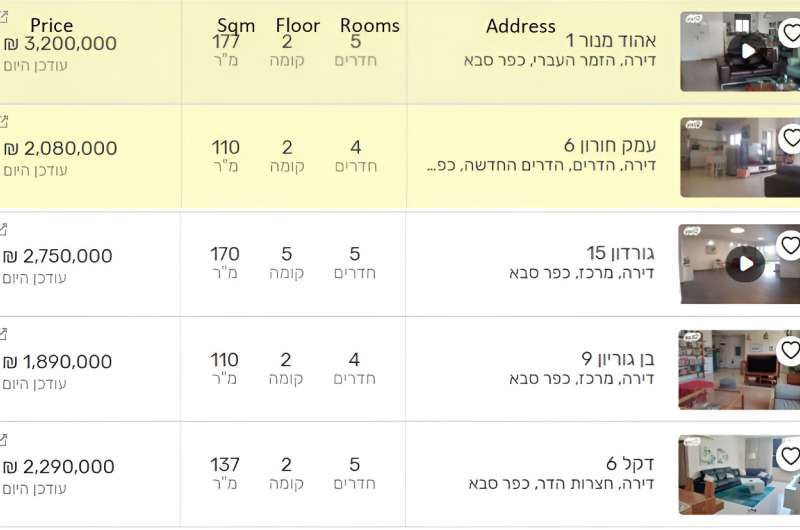
Snapshot of the online listing of units for sale on the YAD2 website. Note: Ads in the Paid category appear higher in the list and are highlighted in color. Photo credit: Real estate economics (2024). DOI: 10.1111/1540-6229.12508
Researchers at Tel Aviv University have found that the zero-price effect can also have costs: Statistically, identical homes posted in free service ads on the Israeli online classifieds service “Yad2” received fewer clicks, sold more slowly, and at a lower price than identical homes posted in paid service ads – resulting in an average net loss of about 3.5 to 3.8 percent of the average transaction price. This equates to about $12,000 to $13,000 when the total price of the paid service is about $70.
The surprising results were part of a study conducted by Prof. Danny Ben-Shahar, director of the Alrov Institute for Real Estate Research at the Coller School of Management at Tel Aviv University, and Dr. David Ash, a research associate at the institute. The article on the findings was recently accepted for publication in the journal Real estate economics.
“We study behavioural economics in the real estate market and in particular the impact of bias in decision making,” explains Prof Ben-Shahar. “We have known for some time that people do not always make rational decisions and one of the more interesting questions is whether these irrational decisions have a price. Here we have studied a bias called the ‘zero price effect’.”
“This effect causes people to overvalue products or services that are offered at zero price. For example, if we lower the price of a product from $2 to $1, demand may increase slightly, but if we lower the price by $1 to zero, demand increases dramatically, which cannot be explained by a rational cost-benefit approach. We wanted to test this effect not in an experimental laboratory setting, but using real data from decisions made in the ‘real world’ – and more importantly, we wanted to test whether this zero-price bias has economic costs.”
In the first part of the study, the researchers examined commercial properties offered for rent on the online platform “Yad2”. In July 2019, the platform had eliminated the possibility of placing ads for the rental of commercial properties. At the same time, it charged higher fees for the premium service, which both highlights the ad and displays it at the top of the search.
“This update allowed us to conduct a quasi-natural experiment with the participation of real people who have to spend real money to rent real properties,” says Prof. Ben-Shahar.
“When the free service became chargeable and the premium service became even more expensive, we found that a significant portion of owners who wanted to rent out their property opted for the premium listing service – even though it became significantly more expensive. The cheaper option lost its appeal once it was no longer completely free.”
Prof. Ben-Shahar and Dr. Ash then showed for the first time how high the price consumers pay for their zero-price bias is. To do this, they examined over 15,000 real estate ads that private homeowners offered for sale on the “Yad2” platform between 2014 and 2016. All ads were without broker commission.
“It is important to understand that for most people, selling a home is the biggest and most important transaction in their lives. For the sellers in our sample, the average sale price is between $350,000 and $500,000,” says Prof. Ben-Shahar.
“‘Yad2′ offers these private sellers the opportunity to post their ads in a free basic service or in a premium service at a negligible total cost of about $70. However, about 95% of sellers preferred the free ad service. Taking into account the different characteristics of the assets, we found that the premium service increased the chances of selling the property by 10-18% daily, increased the number of clicks on the ad by 117-130%, and increased clicks on the sellers’ phone number by 108-122%.
“In other words, those who paid for the premium service achieved higher demand and faster sales. And most importantly, they sold their properties at higher prices. Statistically, identical homes listed on the paid premium service sold for 3.5 to 3.8 percent more than homes listed on the free service. That’s a difference of about $12,000 to $13,000 per sale.”
Further information:
Ash, D. et al. Zero price effect and consumer welfare: insights from the online real estate advertising service, Real estate economics (2024). DOI: 10.1111/1540-6229.12508
Provided by Tel Aviv University
Quote: The real price of the ‘zero price effect’: Study presents evidence from an online real estate classifieds service (2024, August 21), accessed August 21, 2024 from https://phys.org/news/2024-08-real-price-effect-evidence-online.html
This document is subject to copyright. Except for the purposes of private study or research, no part of it may be reproduced without written permission. The contents are for information purposes only.

